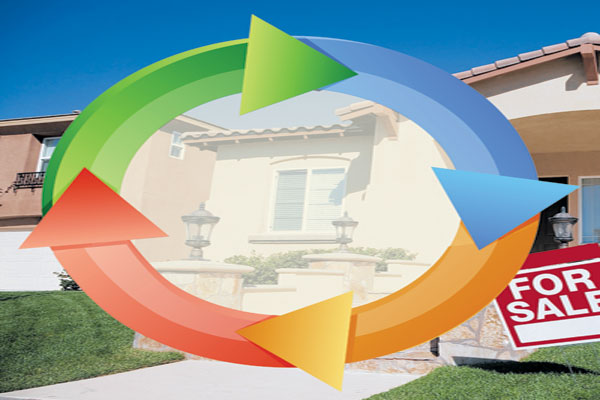*Every market goes through all the four phases. The only element that varies between markets is the time each phase takes. Still, it is just a matter of time before the next recovery or boom. Timing is everything. GRAPHIC | NATION **
By KOSTA KIOLEOGLOU
Over the years, real estate has come to be been considered one of the safest investment options. However, the level of security you enjoy from any investment is directly related your knowledge of, as well as your experience with, the industry. It is also important to be open-minded.
Although property markets follow certain basic rules, each market has its own characteristics. So beliefs such as “You cannot go wrong with real estate in Kenya”, or “Kenya is different from the rest of the world so prices will only keep going up and nothing can change that”, can easily cloud your judgment.
It’s not that Kenya’s real estate market is not as good as those in other parts of the world; it is just that markets all around the world operate in cycles. All property markets, from Dubai to the US, from Asia to Europe, fluctuate.
A property cycle is a logical sequence of recurrent events reflected in factors such as fluctuating prices, vacancies, rentals and demand. Business and economic cycles typically last more than a decade, and they influence property cycles in different ways.
The property market has two cycles, one financial and the other physical. During the financial cycle, capital flows affect prices. Meanwhile, the physical cycle is one of demand and supply, and determines vacancy, which in turn drives rents and values.
The financial cycle determines the price of real estate. During this cycle, local new construction determines supply, while demand is driven by national factors such as interest rates, Treasury bills, monetary policies and the country’s other macroeconomics, which affect investors’ interests in holding commercial real estate (CRE). The preference for CRE above other asset classes (like stocks, bonds, etc.), as well as interest rates, lending standards and liquidity are some of the most important factors that determine this cycle.
FOUR SEASONS
However, when people talk about property cycles, what they usually mean is the physical cycle. This cycle comprises four phases, namely recovery, expansion, hyper supply and recession.
Based on the top diagram on the far right (created by real estate guru Dr Glenn Mueller of the University of Denver), let us try to analyse and understand why these phases occur, what they entail, and the key moments to look out for. It is important to note that this is simply an attempt to explain the pattern and not a reflection of what is happening in a specific market.
Recovery
Before this phase begins, the market is characterised by an oversupply of property both for sale and rental from previous new construction and/or negative growth in demand. Eventually, the excess construction from the previous cycle stops. With few or no new constructions and developments, growing demand slowly absorbs the existing oversupply, leading to the second phase of the market: expansion.
Expansion
During this transitional period, vacancy rates fall, allowing rental rates to stabilse, or even to start increasing. The market dynamics start changing, with the rental yields and rates gradually increasing with the aim of beating pace. Inflation is one of the most important economic factors that determine a successful real estate investment. As a basic principal of a real estate investment, the return on a buy-to-rent investment should at least beat the national inflation rate.
When this happens, governments, through institutions like their central banks, usually take advantage of the momentum and, capitalising on the envisaged growth of the property market, help by reducing interest rates to stimulate the economy.
This makes properties more profitable and attracts investor interest. Eventually, the market reaches its long-term occupancy average, where rental growth is equal to inflation, and the market moves to the next phase, known as the“expansion” or the “boom”.
This phase tends to be the shortest in the cycle and often begins slowly. It is characterised mainly by a rapid increase in real estate prices. Upon realising that property returns are increasing, investors return to the market, often at the same time as property owners are pushing up demand, which eventually leads to an increase in property prices.
The growth in demand increases, creating the need for additional space. Due to limited supply, rents rise rapidly. Eventually, they get to a point where new construction is feasible. What usually happens is that, during the recession and recovery phases, returns from the property market are very low due to the low demand. And because of the unattractive returns, developers lose interest in building. However, when demand rises until it is greater than supply, there is a rapid rise in rent as well as in the growth of property prices. When the returns reach a point where the property market provides profitable investment opportunities and demand is outstrips supply, it makes sense for developers to start building again. During this period, real estate offers every investor’s dream – quick and easy money. As the boom continues, a whole lot of new investors join the market, driven by the hype in the media, property seminars and rumors.
Before long, there is a rush by developers to enter the market. Development and constructions increase, as do prices. At this point greed kicks in, along with speculation.
PSYCHOLOGICAL FACTORS
During the expansion phase, land becomes one of the most popular property assets. Before this phase begins, land owners sell it at its current value. But once the expansion phase begins, land owners, capitalising on the demand, ask for a premium above the current value in anticipation of an increase in property values in the future. This is why land values increase so fast during the expansion phase that it sometimes becomes unaffordable.
A notable characteristic of the expansion phase is that off-plan sales dominate the market as investors rush to cash in by all means, without considering the market dynamics. This marks the onset of the real estate bubble, as prices and increase in rents accelerate further.
This was evident during Kenya’s property boom, when many investors bought property off-plan, hoping to resell it for a profit. However, many of them never really intended occupy the property themselves because often, they didn’t have the means to do so. Although buying off-plan should not be the first option during a “boom”, buyers rush to take advantage of the momentum, causing them to encounter problems with quality, timeframes, and the delivery of projects, as well as negative price changes.
Psychology is one of the most important factors that influence the market. Greed drives property booms as investors see property prices going up all around them and worry that they might miss out on the profits being made by their competitors.
With no understanding of the dynamics of the property cycle, many of them become overconfident at a time when they should probably be most cautious. They are prepared to pay almost any price just to get into the property market, pushing up property prices to levels that are — at least in the medium term — unsustainable and beyond the means of the range of the demand market.
At this stage properties often sell for more than their asking price as eager buyers compete to snap up any property that comes onto the market.
Vendors also become greedy, pushing up the asking prices, which only continues to feed the y boom. As the boom progresses, many builders and developers flood the market with new properties to meet the increasing demand by owner-occupiers and investors. However, at some point, the supply finally catches up with the demand. This key point is called the equilibrium, and marks the end of the expansion phase. Unfortunately, since occupancy rates are at their highest, most real estate participants don’t realise when it occurs.
Hyper supply
The equilibrium in a real estate market is usually identified late. As a result, the market is faced with hyper supply. Instead of taking a break, developers and investors caught between their obligations and the projects that they had already started continue to supply the market with new construction even as demand falls. This causes occupancy rates to fall, and rental growth to slow down. Meanwhile, property values stagnate for a while before they start falling. Those who have recently put up new buildings begin to compete seriously for tenants and buyers.
Eventually, market players realise that there has been a downturn and commitment to new construction should — at least in theory — slow down or stop. If they do so soon enough, the market can avoid a severe downturn or even remain in this phase for a while.
However, due to the lagged nature of construction, this doesn’t always happen. Usually, new constructions continue to come up faster than demand, and occupancy drops below its long-term average. Property values take a negative trend while financial institutions, trying to minimise their exposure from financing the property market, minimise — if not stop completely — any finance related to real estate. This causes the market reach the final phase: recession.
Recession
During this phase, massive oversupply, coupled with negative growth in demand, leads to a decline in rents and property values, leading to losses. Finally, the market panics. This results in further losses, leading the market on a downtrend that sometimes gets out of control.
There are several side-effects during this period that affect the market dynamics even further. The price increases caused by hyper supply often force government institutions like central banks to raise interest rates. But while this has the positive effect of slowing down new construction, it at the same time increases financing costs for existing properties. If interest rates are raised very high, it can lead to potentially painful losses.
If the spread between the bids and asking prices becomes too wide, market liquidity can decline or even become non-existent, making it difficult for landlords to cut their losses easily by selling. Property owners stuck in this situation are forced to make distress sales and bear catastrophic losses.
Usually, real estate represents a large part of the overall economy. This is why during the recession phase, the entire economy suffers, which in turn accelerates the real estate recession dynamics. Foreclosures begin to take place and might even begin to accelerate. The nothing-can-go-wrong belief among investors turns to panic. This leads to a deep recession that takes the market a long time to recover from.
Everybody looks forward to the “the market bottom” (the point where prices stop going down and demand begins to increase again). When the market stabilises, the downturn stops and it slowly starts to enter the recovery phase. That doesn’t occur until new and ongoing constructions stop. This is because, in order for a market to grow, demand must be greater than supply, so the available properties should be fewer than what investors are looking for.
As mentioned at the beginning, every market goes through all the four phases. The only element that varies between markets is the time each phase takes. Still, it is just a matter of time before the next recovery or boom. Timing is everything, so it is important to keep abreast of the market trends. Ensure that you have enough information to identify the prevailing phase of the market so that you can determine the best time to invest in, or sell, your property.
Kosta Kioleoglou is the regional MD of Africa Plantation Capital



